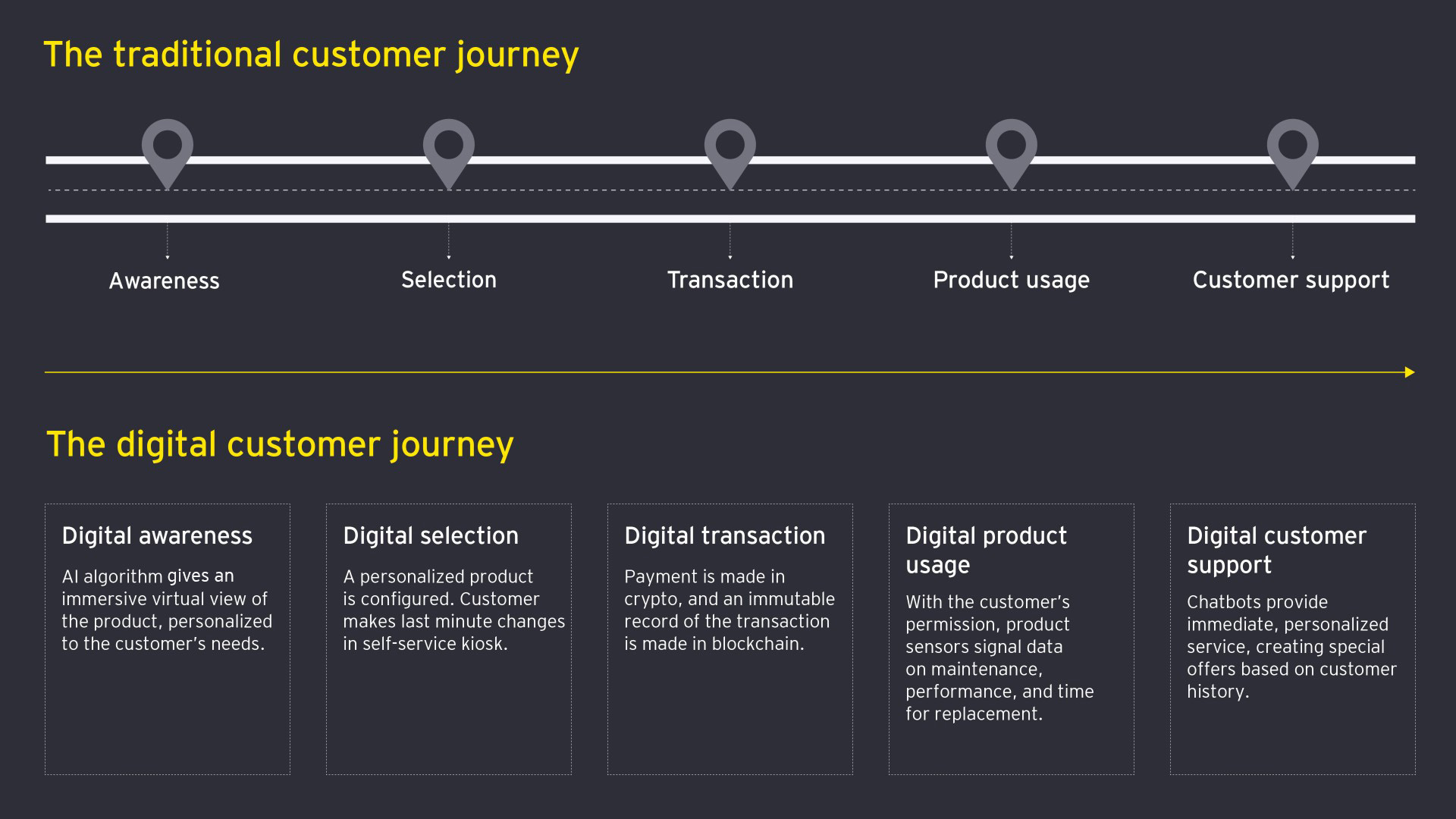
Chapter 1
Customers are moving on — what is at stake for companies?
Organizations must act now to meet the changing customer demands.
While customers report higher levels of digitization, they also report low levels of satisfaction with many of the digital services that they receive. Of the 16,500 global customers surveyed in the EY Future consumer index 2021, key drivers of frustration1 include expense of delivery and shipping (31%), product unavailability (23%), and products damaged in delivery (20%).
Research has found that companies — particularly industry leaders — are painfully aware of the disconnect. The EY Tech Horizon 2022 report found that:
- For industry leaders, the number one goal of digital transformation is meeting changing customer needs — ahead of cutting costs, growing revenue, or reducing risk.
- At the same time, these leaders find that the number one challenge to a successful transformation is tracking and keeping up with changing customer needs.
- On the other hand, the number two challenge is the lack of the right technology and analytics to understand and act upon these changing preferences.
Why are companies struggling to keep pace with their customers? One reason is that it's much simpler for customers, with today’s user-friendly apps, to transition to online food delivery or telehealth visits. It is a much greater challenge for the enterprise to build the interface, analytics, distribution systems and infrastructure to actually deliver the service.
Many traditional companies with legacy systems are struggling to build the infrastructure, data fabric, and user experience — giving digital natives the advantage. (Business ecosystems, which can leverage each partner’s technology advantages, can be used to accelerate adoption.)

Chapter 2
The customer-centric CIO
CIOs need to apply the right technology to map the evolving customer experience.
Customers increasing use of digital is triggering an explosion of data generated at each digital touchpoint in the customer journey and companies are compounding this by further digitizing their products/services. The CIO’s role is to build a digital parallel path — call it the “customer tech stack” — that collects the data, analyzes customer needs, and delivers to the customer.
This digital approach doesn’t just create a new customer experience — it creates a richer, deeper, and real-time customer experience. Here are the steps and the supporting technologies.

- In the awareness phase, artificial intelligence and machine learning provide deep insights into customers, supporting targeted, personalized, and effective awareness campaigns.
- In the consideration stage, personalization technologies enable an offer that is specific to the customer – not one-size-fits-all.
- Virtual and augmented reality can present the customer with deep, immersive messaging.
- Blockchain captures the ecommerce transaction in an immutable format, documenting the sale and establishing ownership.
- When customers use products with digital components (appliances, wearables, vehicles), Internet of Things and edge computing technologies report on usage, maintenance, and customer behaviors.
- After the sale, customers can be cost-effectively served by chat bots using voice recognition and natural language processing.
For simplicity, the schematic shows individual technologies aligned with individual customer journey stages. The reality is that customer-facing technologies will integrate and support each other across the journey. The typical customer will “pinball” between digital and physical — for example, AI-established awareness will lead to a store visit where a digital kiosk will drive online delivery.
The “customer tech stack” is built on the enterprise’s digital foundation, configured for the customer. (Learn more about how leaders are investing in technology such as data, AI and cloud.)
- Companies understand that data is the key to understanding transforming customers — that is why a majority of companies (53%) are making data and analytics the top investment priority, up 50% in the past year.
- Organizations whose transformations are exceeding expectations recognize that customer data is not static – it moves with markets, trends, and competitor moves. That is why 63% of leaders are using AI and machine learning to create new innovative products and predict markets.
- Enterprises are doubling down on cloud as the essential foundation for the multi-channel customer journey — 55% of transformations exceeding expectations include it as top priority for technology investment over the next two years.
Achieving true customer data-centricity can be a challenge for CIOs and their enterprises — only 16% of companies we surveyed believed they were truly data-centric. But this also presents an opportunity for companies to outcompete their peers on data, analytics, and technology.

Chapter 3
Five key steps for CIOs to achieve customer data-centricity
We outline the key actions for CIOs to keep pace with the ever-evolving customer needs.
Few CIO job descriptions include responsibility for the customer experience. But the permeation of technology into every aspect of customers’ lives is making CIOs a critical partner in brand-building, marketing, sales, and other customer-facing functions. Here are five steps every CIO can take to build customer data-centricity into their organization.
- Partner with the Chief Marketing Officer, head of sales, and other customer-facing executives in a Customer Technology Strategy — a holistic plan to how technology will drive a differentiated customer experience at every touchpoint, with data at the core.
- Understand what the customer data is telling you. Collaborate to build deep analytical profiles of customers — including product histories, spend patterns and personal preferences. Leverage external data. Build in AI and machine learning to tell you what will happen. Build in real-time feedback to allow for change.
- Architect your customer technology stack. Set forth your traditional customer journey as a guide. Identify the digital touchpoints. Then map out the roles emerging technologies — such as AI, blockchain and personalization — will play in each step of the journey. Frame out the digital foundation that will be required to support new capabilities.
- Build the holistic data fabric that blankets the customer journey. Customer technology will yield rich data from the customer’s first awareness to the loyalty program. Connecting this data and putting it in the hands of employees, executives and partners will enable your organization to begin shaping demand, rather than reacting to it.
- Get ready for the future. Customer data-centricity is not just a post-pandemic phenomenon. The metaverse will create immersive product advertising. Edge computing will support always-on touchpoints to customer products. Machine learning will build super-insights into demand forecasting. Technology, data, and the CIO will drive business outcomes and revenue as more customers, enterprises and the world go digital.
Related articles
Summary
Recent EY Tech Horizon 2022 research illustrates that organizations list customer experience and meeting changing demands as the most important factors to a successful transformation and the primary objective of most transformation efforts. However, consumer preferences are changing fast with enterprises struggling to catch-up. CIOs play a critical role in tackling this profound change. Investing in the right data and technologies will be key to ensure firms become truly customer data-centric.

